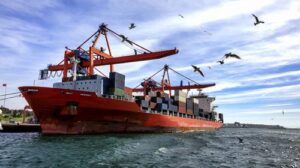
The container and container ship leasing markets, which represent two large equipment leasing subsectors, are on the rebound since a 2015 downturn and recovery is likely to persist through 2018, according to analysis by Fitch Ratings.
Predicted growth comes despite the potentially negative effects of recently proposed US tariffs.
The downturn in the container leasing sector in 2015-2016 was driven by below-average trade volumes, a decline in steel prices and elevated lease expiration levels, as well as the bankruptcy of a major shipping operator, Hanjin Shipping Co. These factors led to lower utilization levels, lease rates and container prices.
According to Harrison Consulting, the price of steel and dry-freight containers fell by approximately 55% for the six-year period following the financial crisis through the recent downturn (2010-2016).
In 2017 and for the year-to-date (YTD), the container market has corrected, driven by lower inventory levels from the four major container manufacturers, leading to increases in lease rates and container prices.
The hot-rolled coil steel index rose 4.6% in 2017 and is up 25% YTD. Steel prices are the main driver of container prices and could further appreciate as a result of the US’s proposed tariffs of 25% on imported steel.
Container lessors own and manage intermodal freight transportation equipment such as dry and refrigerated containers, used by both the trucking and rail industries
The industry’s five leading players – Triton International, Florens Asset Management, Textainer Group, Seaco Asia. and Seacube Container Leasing – collectively accounted for 78% of the leasing market share in 2017 based on fleet size in 20-foot equivalent units (TEUs), according to Drewry Shipping Consultants.
As evidence of the recovery, Triton’s net income was $353.5 million in 2017, compared with a $5.8 million loss in 2016, while Textainer’s net income was $20.7 million in 2017, compared with a $57.9 million loss in 2016. Utilization levels improved for both firms in 2017.
The container ship leasing industry is more fragmented than the container leasing industry.
Market leaders in 2017 were Seaspan, Shoei Kisen Kaisha, Costamare, Dohle Group and Danaos Shipping, according to Alphaliner Monthly Monitor. Container ships require significantly more capital investment than containers, and excess capacity pushed down container ship values in 2015 and 2016, leading to substantial impairments.
However, since the downturn, lower container ship orders, coupled with higher scrapping levels, have driven up asset values and charter rates.
For example, Seaspan recently noted that container ship charter rates for 4,000 TEU panamax vessels improved to $9,000 per day in January 2018, compared to an annual average rate of approximately $7,700 per day in 2017 and an average rate below $5,000 per day in 2016.
Fitch cautions that the recent step-up in US protectionist measures could escalate into a global trade war.
A contraction in global trade would likely result in reduced container throughput that would lower demand for container and container ship leasing.
Despite these risks, the favorable backdrop of strong global GDP growth should support the container and container ship leasing markets in the near term, the consultancy predicts.







